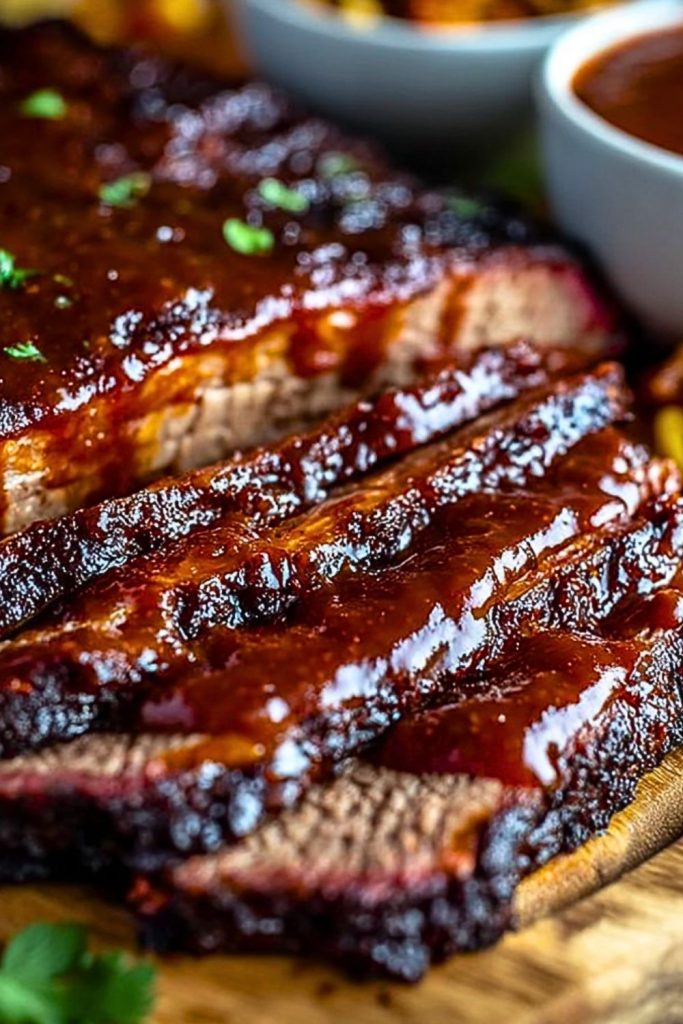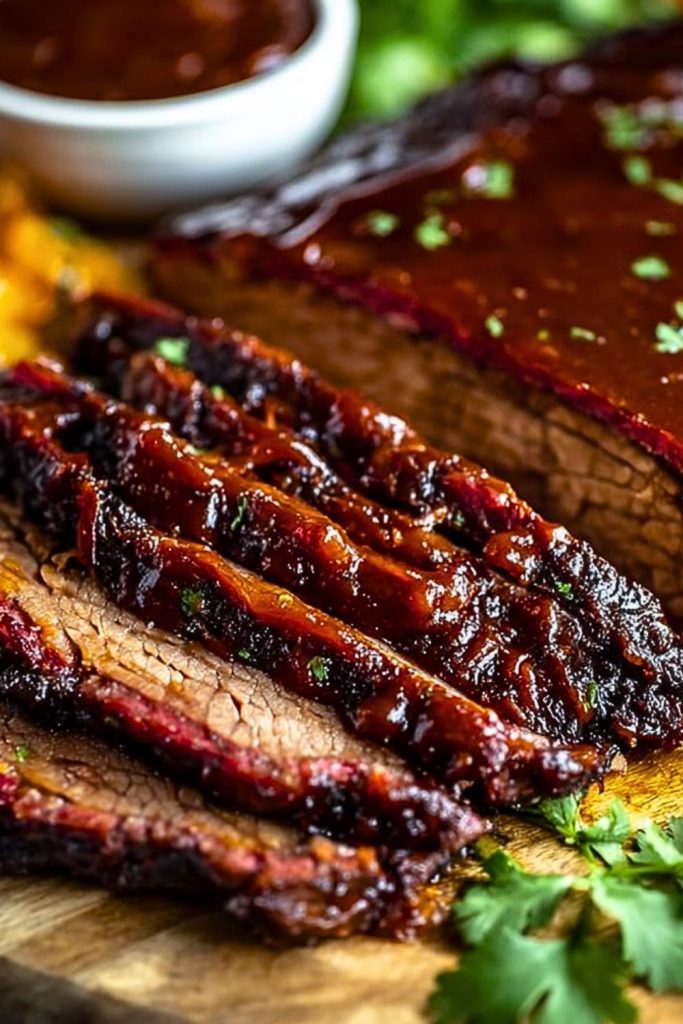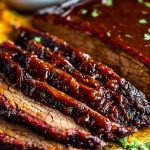Tender, smoky, and dripping with a deep, tangy-sweet glaze — this Juicy Brisket with Rich Homemade Barbecue Sauce is what barbecue dreams are made of. Each slice melts in your mouth with a perfect balance of smoky bark, tender meat, and bold, sticky sauce. Whether you’re cooking for a weekend gathering or aiming to impress at a holiday feast, this brisket delivers maximum flavor with surprisingly approachable steps.

What makes this brisket truly shine is the homemade barbecue sauce. It’s a robust blend of molasses, tangy vinegar, warming spices, and a touch of heat — thick enough to cling to the meat and rich enough to elevate every bite. The bark, the smoke ring, the juiciness — everything comes together to create a show-stopping main dish that’ll have guests scraping the cutting board for seconds.
Why You’ll Love This Juicy Brisket with Rich Homemade Barbecue Sauce
- Flavor-packed and foolproof: You don’t need a professional smoker to make restaurant-quality brisket at home. A few key techniques and slow cooking do all the magic.
- Customizable barbecue sauce: Make it spicy, sweet, or smoky — the homemade sauce can be tailored to your flavor profile.
- Perfect for make-ahead meals: Brisket holds up beautifully when prepped in advance and reheated without drying out.
- Ideal for feeding a crowd: One brisket can serve a hungry group, making it perfect for parties, holidays, or backyard barbecues.
- Tender with a perfect bark: When done right, brisket has both juicy interior slices and a caramelized crust — the best of both worlds.
Preparation Phase & Tools to Use (Essential Tools and Equipment + Their Importance)
Before diving into this smoky masterpiece, it’s important to set yourself up with the right tools. Brisket isn’t complicated, but it does reward those who prep well. Here’s what you’ll need:
- Large Roasting Pan or Smoker: Essential for slow-cooking your brisket evenly. If you’re going oven-style, a roasting pan with a rack keeps the brisket elevated for even heat circulation. If you’re smoking it, a pellet or offset smoker gives it that classic bark and smoke ring.
- Meat Thermometer (Instant-Read or Probe): Precision matters. Brisket is best when cooked low and slow to an internal temperature of about 200°F. A thermometer takes the guesswork out of doneness.
- Sharp Carving Knife: For beautiful, clean slices. Brisket is tender, but still requires a sharp edge to prevent shredding the meat.
- Cutting Board with Juice Groove: Brisket releases juices when sliced — a groove helps catch them and prevent mess.
- Heavy-duty Foil or Butcher Paper: Used during the wrap stage (the “Texas Crutch”) to lock in moisture and tenderize the meat while it finishes cooking.
- Mixing Bowl & Whisk: For making that thick, glossy homemade barbecue sauce.
- Brush or Spoon for Sauce Application: You’ll want an even coat on each slice.
Each of these tools contributes to the final result — from bark texture to internal juiciness. Skimping on the basics might cost you that perfect balance.
Preparation Tips
- Trim Smartly: Leave about ¼ inch of fat on the brisket cap. Too much, and the fat won’t render; too little, and you’ll lose flavor and moisture.
- Bring Meat to Room Temperature: Let the brisket sit out for about 30–45 minutes before cooking. This promotes even cooking.
- Dry Rub Overnight: If time allows, apply your rub the night before and let the brisket sit uncovered in the fridge. This helps the seasoning penetrate deeply and dry out the surface slightly for better bark.
- Low and Slow is Key: Don’t rush it. Brisket takes time, and cooking it too fast will make it tough. Whether you’re using the oven or smoker, 225–250°F is your best friend.
- Resting is Crucial: Let the cooked brisket rest, wrapped in foil and a towel, inside a cooler for at least 1 hour (up to 3). This redistributes the juices and ensures it slices like butter.
Ingredients for This Juicy Brisket with Rich Homemade Barbecue Sauce
Here’s everything you’ll need to bring this bold, smoky brisket to life — from the perfectly balanced dry rub to the rich, sticky barbecue sauce that takes it over the top.
For the Brisket:
- 4–5 lb whole beef brisket (preferably with both point and flat)
- 2 tbsp olive oil (for coating)
- 2 tbsp yellow mustard (optional, helps the rub stick)
For the Dry Rub:
- 2 tbsp brown sugar
- 1 tbsp smoked paprika
- 1 tbsp chili powder
- 1 tbsp garlic powder
- 1 tbsp onion powder
- 2 tsp kosher salt
- 1 tsp ground black pepper
- 1 tsp ground cumin
- ½ tsp cayenne pepper (adjust to taste)
For the Homemade Barbecue Sauce:
- 1 ½ cups ketchup
- ¼ cup apple cider vinegar
- ¼ cup brown sugar
- 2 tbsp molasses
- 1 tbsp Worcestershire sauce
- 1 tsp smoked paprika
- ½ tsp garlic powder
- ½ tsp onion powder
- ¼ tsp ground mustard
- ½ tsp chili flakes or hot sauce (optional for heat)
- Salt and pepper to taste
Optional garnish: Fresh chopped parsley for serving

Step 1: Trim and Prep the Brisket
Place your brisket on a clean cutting board and trim excess fat, leaving about ¼ inch on the fat cap for flavor and moisture. Pat the brisket dry with paper towels. Rub with olive oil (and a light smear of mustard if using) to help the seasoning adhere.
Step 2: Apply the Dry Rub
In a bowl, mix all dry rub ingredients until well combined. Generously coat the brisket on all sides, massaging the rub into every crevice. For best results, wrap the brisket and refrigerate overnight — but you can also let it sit for 1–2 hours at room temperature if you’re short on time.
Step 3: Prepare Your Smoker or Oven
Preheat your smoker or oven to 225°F (107°C). If using a smoker, select your preferred wood chips (hickory, oak, or applewood all work well). Place the brisket fat-side up on the grate or on a rack inside a roasting pan.
Step 4: Cook Low and Slow
Let the brisket cook uncovered until it reaches an internal temperature of about 165°F (usually 4–5 hours). This is when the bark forms. At this point, wrap the brisket tightly in foil or butcher paper to retain moisture, then return to the smoker or oven.
Step 5: Finish Cooking
Continue cooking until the brisket reaches 195–203°F internally — the sweet spot for tenderness. This usually takes another 2–3 hours, depending on your brisket’s size and thickness.
Step 6: Rest the Brisket
Remove the brisket from heat and keep it wrapped. Place it inside a cooler or warm oven and let it rest for at least 1 hour. This allows juices to redistribute, making the meat more tender and flavorful.
Step 7: Make the Barbecue Sauce
While the brisket rests, combine all sauce ingredients in a saucepan over medium heat. Simmer for 10–15 minutes, stirring often, until thick and glossy. Adjust seasoning to taste. You can blend it for a smoother texture if desired.
Step 8: Slice and Serve
Slice the brisket against the grain into ¼ to ½ inch slices. Spoon the warm barbecue sauce generously over the meat, and garnish with fresh parsley if using. Serve immediately with your favorite sides.
Notes
- Fat Cap Placement Matters: Always cook brisket fat-side up — this lets the fat baste the meat as it renders down, resulting in juicier slices.
- Use a Water Pan (Optional but Helpful): If you’re smoking or oven-roasting for long hours, placing a water pan in the cooker helps maintain moisture and keeps the bark from drying out.
- Save the Juices: After cooking and resting, collect the juices from the foil or paper wrap. Skim the fat and mix the liquid back into sliced brisket or barbecue sauce for extra flavor.
- Wrap at the Stall: When the internal temp stalls around 160–165°F, wrapping it helps push through to tenderness faster while keeping the bark intact.
Watch Out for These Mistakes While Cooking
- Not Trimming Correctly: Leaving too much fat or trimming it all off can ruin texture and flavor. Aim for a balanced trim — leave just enough for moisture.
- Skipping the Rest Period: Cutting into brisket immediately after cooking will let all the juices escape. Always rest the meat for at least an hour.
- Slicing the Wrong Way: Brisket must be sliced against the grain to avoid stringy, tough bites. This is crucial for tenderness.
- Using High Heat: Brisket is a tough cut. Cooking it quickly or at high heat leads to chewy, dry meat. Patience is your best ingredient here.
- Over-smoking or Over-saucing: Smoke and sauce should enhance, not overpower. Go light at first and build flavor as needed.
- Using a Dull Knife: A dull blade will tear the brisket and ruin presentation. Use a sharp slicing or carving knife for clean cuts.
- Not Monitoring Temperature Closely: Internal temp, not time, determines doneness. Always cook by thermometer, not by the clock.
- Using Cold Brisket from the Fridge: Throwing fridge-cold brisket directly into the smoker or oven can shock the meat and lead to uneven cooking. Let it come to room temp first.
What to Serve With Juicy Brisket with Rich Homemade Barbecue Sauce?
A brisket this bold and juicy deserves a strong supporting cast. Whether you’re going for a classic BBQ platter or a more elevated dinner spread, the right sides can make your brisket shine even brighter.
8 Recommendations:
1. Creamy Coleslaw
The crunchy, tangy freshness of coleslaw balances the richness of brisket and cuts through the smoky fat beautifully.
2. Garlic Mashed Potatoes
Buttery, fluffy, and a little garlicky — mashed potatoes make a hearty, comforting side that pairs incredibly well with the saucy meat.
3. Smoked Mac & Cheese
Rich, gooey, and slightly smoky, mac and cheese holds its own next to brisket while adding creamy contrast.
4. Grilled Corn on the Cob
Sweet corn with a bit of char and a brush of butter is a simple but effective side that adds texture and flavor.
5. Pickles or Pickled Red Onions
The acidity helps refresh the palate and complements the sweetness of the barbecue sauce.
6. Southern Baked Beans
Hearty and just a little sweet, baked beans are a barbecue staple that add extra depth to your plate.
7. Buttermilk Cornbread
Slightly sweet, tender, and perfect for sopping up extra sauce and brisket juices.
8. Roasted Brussels Sprouts or Asparagus
Add a touch of green to your plate with these earthy, oven-roasted vegetables for balance and nutrition.
Storage Instructions
Brisket makes some of the best leftovers, and proper storage ensures it stays juicy and flavorful even days later. Here’s how to do it right:
Refrigerating:
- Cool completely before storing.
- Slice only what you plan to eat. Keep the remaining brisket whole to preserve moisture.
- Store in an airtight container or wrap tightly in foil or plastic wrap.
- Pour some of the reserved cooking juices or extra barbecue sauce over the meat to prevent it from drying out.
- Keeps well in the fridge for up to 4 days.
Freezing:
- Wrap brisket slices (or the whole piece) tightly in heavy-duty foil, then place in a freezer-safe bag or container.
- Add a spoonful of sauce or juice to each portion before freezing.
- Label and date it. Brisket freezes beautifully for up to 3 months.
- To reheat, thaw overnight in the fridge, then warm gently in the oven at 275°F, covered, until heated through.
Estimated Nutrition
Please note: These values are approximate and based on a 6-ounce serving of brisket with barbecue sauce.
- Calories: 430
- Protein: 38g
- Total Fat: 24g
- Saturated Fat: 8g
- Trans Fat: 0g
- Carbohydrates: 18g
- Sugars: 14g
- Fiber: 1g
- Cholesterol: 110mg
- Sodium: 620mg
Nutrition will vary slightly based on the cut of brisket and exact ingredients used in your rub and sauce.
Frequently Asked Questions
1. Can I make brisket in the oven instead of a smoker?
Absolutely. You can slow-roast the brisket in your oven at 225°F following the same steps. You’ll still get a tender, flavorful result — just without the smoky flavor (unless you add a dash of liquid smoke to your rub or sauce).
2. How do I know when the brisket is done?
The most reliable method is temperature: brisket is ready when it reaches 195–203°F internally. It should feel tender when probed and have a slight jiggle when lifted.
3. What’s the difference between the flat and point of the brisket?
The flat is leaner and better for slicing, while the point is fattier and ideal for burnt ends or shredding. A full brisket (also called a “packer”) includes both cuts.
4. How can I make the barbecue sauce spicier or sweeter?
To make it spicier, add cayenne pepper, chili flakes, or hot sauce. For extra sweetness, increase the brown sugar or molasses. Always taste and adjust to your preference.
5. Can I prepare the brisket the day before serving?
Yes! Brisket actually tastes better the next day. Cook it fully, let it cool, then refrigerate. Reheat slowly in the oven with added sauce or juice to keep it moist.
6. Why does brisket “stall” during cooking?
The stall is a natural part of the cooking process when the meat hits about 160–165°F. Moisture evaporates from the surface, cooling it down. Wrapping the brisket helps push through the stall more quickly.
7. Can I make this recipe without the homemade barbecue sauce?
Yes. The brisket is flavorful enough on its own, especially with a good dry rub. But the sauce adds richness and moisture — and is highly recommended for the full experience.
8. Is this recipe gluten-free?
It can be! Just make sure your Worcestershire sauce, mustard, and spices are certified gluten-free, and you’re good to go.
Conclusion
This Juicy Brisket with Rich Homemade Barbecue Sauce is more than just a meal — it’s a celebration of deep flavors, patient cooking, and satisfying results. Whether you’re serving a backyard crowd, prepping for a holiday feast, or just craving an unforgettable dinner, this brisket delivers every time.
From the bold rub to the sticky, tangy barbecue sauce, every step is designed to build layers of flavor and texture that impress. And with leftovers that taste even better the next day, it’s a recipe you’ll come back to again and again.

Juicy Brisket with Rich Homemade Barbecue Sauce
- Prep Time: 20 minutes
- Cook Time: 7–8 hours
- Total Time: 8.5 hours
- Yield: 8–10
- Category: Dinner
- Method: Slow roast / smoking
- Cuisine: American BBQ
Description
Sink your teeth into this Juicy Brisket with Rich Homemade Barbecue Sauce, a bold and flavorful dish that transforms a simple cut of beef into a slow-cooked masterpiece. It’s the ultimate crowd-pleaser — fork-tender meat with a smoky dry rub crust and a homemade barbecue sauce that’s sweet, tangy, and just a little spicy. Whether you’re looking for easy dinner ideas, holiday food ideas, or just an impressive yet easy recipe for your next get-together, this brisket delivers every time. Perfect for meal prep, backyard BBQs, or hearty dinner ideas that keep people talking.
Ingredients
4–5 lb beef brisket
2 tbsp olive oil
2 tbsp yellow mustard
2 tbsp brown sugar
1 tbsp smoked paprika
1 tbsp chili powder
1 tbsp garlic powder
1 tbsp onion powder
2 tsp kosher salt
1 tsp ground black pepper
1 tsp ground cumin
0.5 tsp cayenne pepper
1.5 cups ketchup
0.25 cup apple cider vinegar
0.25 cup brown sugar
2 tbsp molasses
1 tbsp Worcestershire sauce
1 tsp smoked paprika
0.5 tsp garlic powder
0.5 tsp onion powder
0.25 tsp ground mustard
0.5 tsp chili flakes
salt and pepper to taste
Instructions
1. Trim excess fat from brisket, leaving about ¼ inch of fat cap. Pat dry and coat with olive oil and mustard.
2. Combine all dry rub ingredients and massage thoroughly into brisket. Refrigerate overnight or rest at room temp for 1–2 hours.
3. Preheat smoker or oven to 225°F. Add wood chips if smoking. Place brisket fat-side up on a rack or grate.
4. Cook uncovered until internal temperature reaches 165°F (about 4–5 hours). Wrap in foil or butcher paper.
5. Continue cooking until internal temperature reaches 195–203°F (another 2–3 hours).
6. Remove and rest brisket, still wrapped, in a cooler or warm oven for at least 1 hour.
7. Meanwhile, combine sauce ingredients in a saucepan and simmer for 10–15 minutes until thickened.
8. Slice brisket against the grain. Spoon warm barbecue sauce over top and serve hot.
Notes
Always slice the brisket against the grain for maximum tenderness.
Resting the meat after cooking is non-negotiable — it seals in the juices.
Make extra barbecue sauce — it doubles as a dipping sauce or sandwich spread.
Nutrition
- Serving Size: 6 oz
- Calories: 430
- Sugar: 14g
- Sodium: 620mg
- Fat: 24g
- Saturated Fat: 8g
- Unsaturated Fat: 15g
- Trans Fat: 0g
- Carbohydrates: 18g
- Fiber: 1g
- Protein: 38g
- Cholesterol: 110mg
Keywords: brisket, barbecue, easy dinner, slow-cooked beef, BBQ ideas, homemade BBQ sauce

